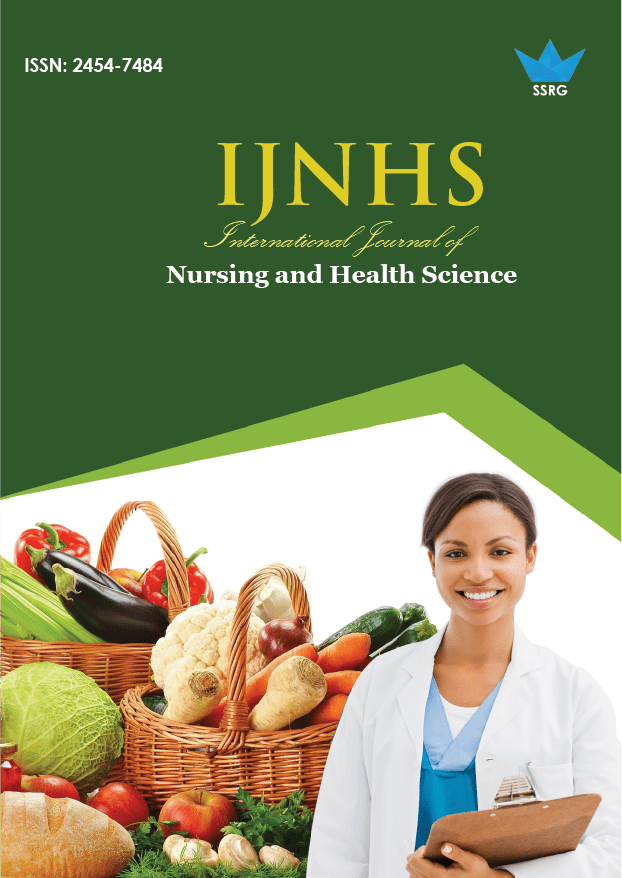A Comparative Study To Assess The Stress-Related Problems And Reactions of M.Sc. Nursing And Non-Nursing P.G. Students: A Prospective Study

| International Journal of Nursing and Health Science |
| © 2021 by SSRG - IJNHS Journal |
| Volume 7 Issue 2 |
| Year of Publication : 2021 |
| Authors : Shamina Bhandari, Veena Sharma, Madhubala Handa |
How to Cite?
Shamina Bhandari, Veena Sharma, Madhubala Handa, "A Comparative Study To Assess The Stress-Related Problems And Reactions of M.Sc. Nursing And Non-Nursing P.G. Students: A Prospective Study," SSRG International Journal of Nursing and Health Science, vol. 7, no. 2, pp. 32-42, 2021. Crossref, https://doi.org/10.14445/24547484/IJNHS-V7I2P106
Abstract:
A. Aim: In recent years, there is an increasing concern about the stresses involved in nursing training. Nursing educators need to know the occurrence of physical distress and psychological well-being among nursing students. The present study aimed to do a comparative study to assess the stress-related problems and reactions of M.Sc. Nursing and Non-Nursing - P.G. students in a nursing college located in North India. It is a unique study that is not conducted to compare in this part of the world to compare and observed physical and psychological stress between Nursing and non-Nursing post-graduate students in Northern India.
B. Materials and Methods:
A comparative study to assess the stress-related problem and stress reactions of M.Sc. Nursing (32 students) and Non-Nursing P.G. students (32) in a selected University of Delhi to develop and disseminate guidelines to cope with study-related stress was undertaken at Rufaida College of Nursing, Jamia Hamdard, Delhi.
C. Results:
Majority of M.Sc. Nursing students, i.e., 6 (18.75%) had a mild degree of stress, 18 (56.25%) had a moderate degree of stress, and 8(25%) had a severe degree of stress. Among Non-Nursing P.G. students, 8(25%) had a mild degree of stress, 21(65.625%) had a moderate degree of stress, and 3(9.375%) had a severe degree of stress. D. Conclusion: The data of the present study point out that nursing students experienced higher levels of stress. Hence, the authorities need to take measures, such as creating a congenial environment to reduce stress among the nursing students.
Keywords:
Nursing college, stress, P.G. students
References:
[1] Dhar N, Nandan D. Stress – a public health menace of the day Combat it 2008, National Institute of Health and Family Welfare. [Last accessed on 8 Apr 2012]. Available from: http://www.nihfw.org/Publications/News_letter.html.
[2] Kumar S, Dagli RJ, Mathur A, Jain M, Prabu D, Kulkarni S. Perceived sources of stress amongst Indian dental students. Eur J Dent Educ. 2009;13:39–45. [PubMed] [Google Scholar]
[3] Lamk AL. Stress in the Medical Profession and its roots in Medical School. SQU Med J. 2010;10:156–9. [PMC free article] [PubMed] [Google Scholar]
[4] (Behere et al., 2011). Behere SP, Yadav R, Behere PB., A comparative study of stress among students of medicine, engineering, and nursing. Indian Journal of Physiological Medicine., 33(2) (2011) 145-148.
[5] Sherina MS, Rampal L, Kaneson N. Psychological Stress Among Undergraduate Medical Students. Med J Malaysia., (2004) 59:207–11. [PubMed] [Google Scholar]
[6] Deary IJ, Watson R, Hogston R. A longitudinal cohort study of burnout and attrition in nursing students. J Adv Nurs, 43 (2003) 71–81. [PubMed] [Google Scholar]
[7] Sharma N, Kaur A. Factors associated with stress among nursing students. Nurs Midwifery Res J., 7 (2011) 12–21. [Google Scholar]
[8] Abhishek Singh, Mukul Chopra,1 Siddiqui Adiba,2 Prasanna Mithra,3 Anu Bhardwaj,4 Rakesh Arya, Pankaj Chikkara,5 Rajesh Duraisamy Rathinam,6 and Sanjeet Panesar7.A descriptive study of perceived stress among the North Indian nursing undergraduate students. Iran J Nurs Midwifery Res, 18(4) (2013) 340–342.
[9] Gibbons C, Dempster M, Moutray M. Stress, coping and satisfaction in nursing students. J Adv Nurs., 67 (2011) 621–32. [PubMed] [Google Scholar].
[10] Sheu S, Lin HS, Hwang SL. Perceived stress and physiopsycho- social status of nursing students during their initial period of clinical practice. Int J Nurs Stud., 39 (2002) 165–75. [PubMed] [Google Scholar].
[11] Jones MC, Johnston DW. Reducing distress in the first level and student nurses. A review of the applied stress management literature. J Adv Nurs., 32 (2000) 66–74. [PubMed] [Google Scholar].
[12] Graneheim UH, Lundman B. Qualitative content analysis in nursing research: Concepts, procedures, and measures to achieve trustworthiness. Nurse Educ Today., 24 (2004) 105–12. [PubMed] [Google Scholar].
[13] Ruth Lo. Experiencing before and throughout the nursing career. J Adv Nurs., 39(119) (2002). [PubMed] [Google Scholar]
[14] Sherring S, Knight D. An exploration of burnout among city mental health nurses. Br J Nurs., 18 (2009) 1234–40. [PubMed] [Google Scholar]
[15] Nolan G, Ryan D. Experience of stress in psychiatric nursing students in Ireland. Nurs Stand., 22 (2008) 35–43. [PubMed] [Google Scholar]
[16] Mandeep Kaur1, Kanika Guleria2, Anisha3 1Study to Assess the Level of Stress among Nursing students. Medico-legal Update, 21(2021).
[17] Kim., et al. perceived levels and sources of anxiety of senior nursing students in the clinical setting: dissertation abstracts international, 58(4-B) (1997) 1801.
[18] Samah Anwar Mohamed Shalaby, Sara Mahdi Swaid AlDilh (2015) Exploring the Relationship between Perceived Stress and Academic Achievement among Critical Care Nursing Students Athens Journal of Health – 2(4) 283-296 https://doi.org/10.30958/ajh.2-4-4 doi=10.30958/ajh.2-4-4 ].
[19] Kumar P, et al. Academic Stress among Nursing Students. Nurs Health Care Int J., 4(3) (2020) 000227.
[20] Kimarie Brown 1, Pauline Anderson-Johnson 2, Andrea Norman McPherson. Academic-related stress among graduate students in nursing in a Jamaican school of nursing. Nurse Educ Pract ., 20 (2016) 117-24. doi: 10.1016/j.nepr.2016.08.004. Epub 2016 Aug 21.

 10.14445/24547484/IJNHS-V7I2P106
10.14445/24547484/IJNHS-V7I2P106